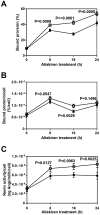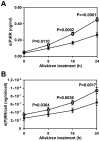Aliskiren reduces the release of soluble (pro)renin receptor from human umbilical vein endothelial cells
- PMID: 30271601
- PMCID: PMC6158390
- DOI: 10.3892/br.2018.1124
Aliskiren reduces the release of soluble (pro)renin receptor from human umbilical vein endothelial cells
Abstract
(Pro)renin receptor [(P)RR] has been implicated in diverse biological processes through binding to its ligands, which include renin, prorenin, Wnt signaling molecules and subunits of vascular H+-ATPase. Recent studies have reported that (P)RR is implicated in pathophysiological conditions including retinopathy and pancreatic ductal adenocarcinoma, and the soluble form of this receptor [s(P)RR] is considered as a useful biomarker for diseases. The present study examined the effect of aliskiren, the first orally active direct renin inhibitor, on the protein levels of (P)RR using cultured human umbilical vein endothelial cells (HUVECs). The cells were treated with or without aliskiren (10 nM) at 37°C for different durations (0, 8, 16 and 24 h). Aliskiren-treated HUVECs exhibited reduced proliferation compared with those treated without the drug. Furthermore, aliskiren treatment decreased not only the level of exogenous prorenin that bound to the membranes of HUVECs, but also the renin activity derived from this binding activity. These results indicate that the quantity of full-length (P)RR was reduced by aliskiren treatment, and furthermore, that the level of s(P)RR released from HUVECs was decreased with the treatment. Recent study has reported that s(P)RR exerted antidiuretic function. The current study suggests that the levels of s(P)RR, as a potential antidiuretic molecule and prospective disease biomarker, may be decreased during anti-hypertensive treatments with aliskiren.
Keywords: aliskiren; human umbilical vein endothelial cells; prorenin; soluble (pro)renin receptor.
Figures




References
-
- Nabi AHMN, Biswas KB, Ebihara A, Nakagawa T, Suzuki F. Renin angiotensin system in the context of renin, prorenin, and the (pro)renin receptor. Rev Agric Sci. 2013;1:43–60.
LinkOut - more resources
Full Text Sources
